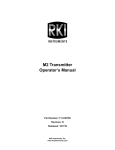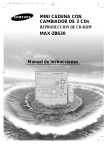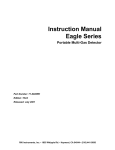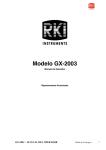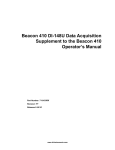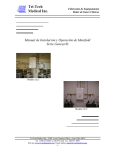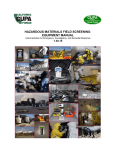Download RKI Instruments M2 Operator`s manual
Transcript
30-0954RK-200 Series Sample Draw Aspirator Adapter Operator’s Manual Part Number: 71-0188RK Revision: E Released: 5/16/12 www.rkiinstruments.com WARNING Read and understand this instruction manual before operating detector. Improper use of the detector could result in bodily harm or death. Periodic calibration and maintenance of the detector is essential for proper operation and correct readings. Please calibrate and maintain this detector regularly! Frequency of calibration depends upon the type of use you have and the sensor types. Typical calibration frequencies for most applications are between 3 and 6 months, but can be required more often or less often based on your usage. 30-0954RK-200 Series Sample Draw Aspirator Adapter Product Warranty RKI Instruments, Inc. warrants gas alarm equipment sold by us to be free from defects in materials, workmanship, and performance for a period of one year from the date of shipment from RKI Instruments, Inc. Any parts found defective within that period will be repaired or replaced, at our option, free of charge. Parts must be returned to RKI Instruments, Inc. for repair or replacement. This warranty does not apply to those items which by their nature are subject to deterioration or consumption in normal service, and which must be cleaned, repaired or replaced on a routine basis. Examples of such items are: a) Pump diaphragms and valves c) Batteries b) Fuses d) Filter elements Warranty is voided by abuse including mechanical damage, alteration, rough handling, or repair procedures not in accordance with instruction manual. This warranty indicates the full extend of our liability, and we are not responsible for removal or replacement costs, local repair costs, transportation costs, or contingent expenses incurred without our prior approval. THIS WARRANTY IS EXPRESSLY IN LIEU OF ANY AND ALL OTHER WARRANTIES AND REPRESENTATIONS, EXPRESSED OR IMPLIED, AND ALL OTHER OBLIGATIONS OR LIABILITIES ON THE PART OF RKI INSTRUMENTS, INC. INCLUDING BUT NOT LIMITED TO, THE WARRANTY OF MERCHANTABILITY OR FITNESS FOR A PARTICULAR PURPOSE. IN NO EVENT SHALL RKI INSTRUMENTS, INC. BE LIABLE FOR INDIRECT, INCIDENTAL OR CONSEQUENTIAL LOSS OR DAMAGE OF ANY KIND CONNECTED WITH THE USE OF ITS PRODUCTS OR FAILURE OF ITS PRODUCTS TO FUNCTION OR OPERATE PROPERLY. This warranty covers instruments and parts sold to users only by authorized distributors, dealers and representatives as appointed by RKI Instruments, Inc. We do not assume indemnification for any accident or damage caused by the operation of this gas monitor and our warranty is limited to the replacement of parts or our complete goods. Warranty covers parts and labor performed at RKI Instruments, Inc. only, and does not cover field labor or shipment of parts back to RKI. 30-0954RK-200 Series Sample Draw Aspirator Adapter Overview This manual describes the 30-0954RK-200 Series sample draw aspirator adapter. It also describes how to install and use the adapter. A spare parts list at the end of this manual lists replacement parts. Specifications Table 1 lists specifications for the Sample Draw Aspirator Adapter. Table 1: Specifications Applicable Detector Heads RKI S Series, S2 Series, M2, or direct connect detector head Maximum Compressed Air Supply Pressure 140 PSI Outlet Pressure to Aspirator 5 - 50 PSI adjustable (determined by required flow rate) Recommended Sample Flow Rate 3 SCFH (standard cubic feet per hour) WARNING: When using the 30-0954RK-200 Series, you must follow the instructions and warnings in this manual to assure proper and safe operation of the 30-0954RK-200 Series and to minimize the risk of personal injury. Be sure to maintain and calibrate the 30-0954RK-200 Series as described in this manual. Description The sample draw aspirator adapter uses compressed air flowing through a venturi to draw air into a sample chamber. Detector Head 2 (optional) Calibration Gas Fitting Flow Meter Detector Head 1 Flow Fail Switch Inlet/Blowback Valve Calibration Valve Sample Filter Compressed Air In Regulator Aspirator Exhaust Restrictor V (Vaccum Port) Figure 1: Flow Diagram 1 • 30-0954RK-200 Series Sample Draw Aspirator Adapter Drain Fault Switch Flow Meter Detector Head with Chamber Detector Head with Chamber 1 2 IN (optional) IN Calibration Valve Push Button OUT OUT Calibration Valve Pressure Adjustment Knob Pressure Gauge Pressure Regulator Aspirator Calibration Fitting Drain Fault Switch Low Flow Switch Aspirator/Sample Exhaust (1/8 NPT female) Adjustment Screw - + Inlet/Blowback Valve Low Flow and Drain Fault Contact Housing Water Trap Inlet/Blowback Valve Button 1/4 O.D. Tube Compressed Air Inlet Fitting 1/4 O.D. Tube Sample Inlet Fitting Figure 2: Component Location The sample draw adapter consists of eleven major components (see Figure 2 ): the detector head (1 or 2), regulator, aspirator, detector adapter, detector chamber (1 or 2), flowmeter, calibration valve, inlet/blowback valve, low flow switch, drain fault switch, and low flow and drain fault contact housing. Detector Head(s) Each detector head provides a signal that can be used by a controller to indicate the sample gas level. Any RKI S Series, S2 Series, M2, or direct connect detector head can be used with the sample drawing adapter plate. Figure 2 above shows the approximate location of the two detector heads. Please see the detector head operator’s manual of the detector head(s) in your system for a complete description of the detector head(s). 30-0954RK-200 Series Sample Draw Aspirator Adapter • 2 Regulator The regulator has an inlet port on its left side with a 1/4” tube fitting. The maximum allowable inlet pressure is 140 PSI. A gauge at the bottom of the regulator indicates the output pressure. The output pressure, and detector flow, can be adjusted using the knob on the front of the regulator. The detector flow rises or falls as the output pressure is increased or decreased. Aspirator The aspirator inlet is connected to the output port on the right side of the regulator and the vacuum port on top is connected to the detector chamber. It has a venturi tube inside it which generates a vacuum at its top port when compressed air flows through it. The compressed air and the air drawn from the detector chamber into the top port of the aspirator both exhaust at the right side of the aspirator. Detector Adapter The detector adapter screws directly onto the detector. It is installed hand tight. It has a gasket inside it which seals against the detector. When removing this adapter to change the detector, be sure not to lose this gasket. Each specific sensor requires its own detector adapter. Detector Chamber The chamber has three thumbscrews which fasten it to the detector adapter. An O-ring at the top of the chamber seals the chamber/adapter interface. The inlet of the chamber is on the side and is connected to the exhaust of the flowmeter. The exhaust of the chamber is at the bottom and is connected to the vacuum port of the aspirator. Flowmeter The flowmeter indicates the flow to the detector(s). It has a 1/4” OD tube fitting at its inlet and exhaust port. The exhaust port of the flow meter is connected to the detector chamber or to the first detector chamber if two detector heads are installed. The flowmeter’s indication range is 1 - 10 SCFH. It has no flow adjustment valve because the flowrate is controlled by the regulator setting. Calibration Valve The calibration valve is a manual operation spring return valve with a push button actuator. This valve is used to switch from sample flow to calibration gas during the calibration process. When the button is pushed and held, the sample port is closed and the calibration port is opened. Inlet/Blowback Valve The inlet/blowback valve is a manual operation spring return valve. A push button actuator is located on the front of the valve. This valve is used to switch from sample flow to blow back in the event of a clogged sample line. When the push button is pressed and held, the valve diverts the compressed air supply back through the sample line to clear obstructions. WARNING: The blowback pressure can be as high as 140 PSI. Make sure that all personnel and equipment are clear of the sample line inlet end to avoid personal injury or equipment damage if a sample line obstruction is blown out of the sample line. Low Flow/Drain Fault Contact Housing The low flow switch provides open contacts in normal operation in the low flow/drain fault contact housing that close in the event of a low flow condition. Two contact wires protrude from the side of the switch and enter the low flow contact housing through a plastic cable bushing on the left side of the housing. Terminals are provided in the low flow/drain fault contact housing for field connection to the switch contacts. 3 • 30-0954RK-200 Series Sample Draw Aspirator Adapter The drain fault switch senses a break or very low flow in the water drain line and provides open contacts in normal operation in the low flow/drain fault contact housing which close when the switch senses a break, a very low drain flow, or a shut down. Connecting monitoring devices to the low flow and drain fault contact terminals provides the user with a notification of a contact closure. Each set of contacts may have their own monitoring device or they may share one. See “Installation” on page 4 for instructions to wire these terminals using the two scenarios. A second plastic cable bushing on the bottom of the low flow/drain fault contact housing allows for cable entry to the housing. The size range of the cable which can be routed through the second cable bushing is .064’’ - .210’’ OD. Installation (4X) Ø 0.50 19.25 0.75 Detector Head with Chamber Detector Head with Chamber 1 2 (optional) IN IN Low Flow and Drain Fault Contact Housing OUT OUT 19.25 20.75 Aspirator/Sample Exhaust - + Field Wiring Cable Entry Bushing for Switch Contact 0.75 140 PSI Compressed Air Inlet Sample Inlet 20.75 Figure 3: Outline & Mounting Dimensions 1. Install the mounting panel to a flat vertical surface using the four mounting holes (0.50’’ diameter) in the corners of the panel. Make sure that sufficient space is allowed to remove the 30-0954RK-200 Series Sample Draw Aspirator Adapter • 4 detector head’s cover, and to bring power/signal wiring to the detector head. Also provide sufficient clearance for routing of sample, compressed air, and exhaust lines. 2. Connect power/signal wiring to the detector head(s) as described in the detector head operator’s manual. 3. Connect a contact monitoring device to the low flow and drain fault contact terminals inside the low flow and drain fault contact housing using the field wiring cable entry bushing. The contacts may be wired individually or in parallel. When wired individually, you will need one monitoring device for each set of contacts. When a specific monitoring device goes into alarm, you will immediately know which set of contacts closed and what the problem is. When wired in parallel, only one monitoring device is needed to monitor both sets of contacts. However, when that device goes into alarm, it will be unclear which set of contacts closed without further investigation. Wiring diagrams for each scenario are shown below. Contact Monitoring Device Drain Fault Contact Terminal Block Yellow Yellow Factory Wired Blue Blue Factory Wired Contact Monitoring Device Low Flow Figure 4: Low Flow and Drain Fault Wiring, Independent Wiring Drain Fault Yellow Factory Wired Yellow Blue Blue Factory Wired Low Flow 5 • 30-0954RK-200 Series Sample Draw Aspirator Adapter Contact Terminal Block Contact Monitoring Device Figure 5: Low Flow and Drain Fault Wiring, Parallel Wiring 4. Start up the detector head(s) as described in the detector head operator’s manual. 5. Connect a sample line from the area to be sampled to the sample inlet fitting at the bottom right of the panel. The fitting accepts 1/4” OD rigid metal tubing such as copper, aluminum, or stainless steel tubing. Be sure to use tubing appropriate for the target gas. 6. The aspirator exhaust includes the sample air. It may be routed to a different area where it can be exhausted safely by running tubing from the aspirator exhaust fitting to the “safe” area. The aspirator exhaust fitting is a 1/4’’ OD tubing fitting. 7. Turn the regulator adjustment knob completely counterclockwise and then turn it one turn clockwise so that the flow will start out at a low level when the compressed air is connected and turned on. 8. Connect a compressed air source up to a maximum of 140 PSI to the inlet of the regulator. Although the regulator is rated up to 300 PSI inlet pressure, other components are rated to a maximum of 140 PSI. 9. Adjust the regulator adjustment knob so that the flowmeter indicates 3 SCFH. The regulator exhaust pressure indicated by the regulator gauge will vary for a particular flow depending on the length of the sample line and other restrictions such as filters. Typically the pressure will be between 5 and 10 PSI for short sample runs. It will be higher for longer sample runs and if filters are used. 10. Calibrate the detector head(s) as described below. Calibration 1. Follow the instructions in the detector head operator’s manual for setting the zero (fresh air) reading and making span adjustments. 2. When introducing gas to the detector, fill a gas sample bag with a regulator or dispensing valve. See “Parts List” on page 8 for available parts. NOTE: A gas bag is recommended for calibration instead of a demand flow regulator because a demand flow regulator introduces enough flow restriction to significantly reduce the flow. If a demand flow regulator is used, the flow will have to be adjusted up to 3 SCFH while the regulator is connected during calibration and down to 3 SCFH after calibration. 3. Connect the sample bag tubing to the hose barb calibration fitting on the calibration valve. 4. Push and hold the button on the calibration valve to start the flow of gas through the calibration gas fitting. Allow the sample draw adapter to draw sample for 2 minutes and then make any calibration adjustments necessary. 5. Release the push button on the calibration valve. Disconnect the sample bag from the calibration fitting. Blowback Operation 1. In the event of a clogged sample line, the blowback valve can be used to divert the compressed air supply back through the sample line to clear obstructions. 2. Inspect the sample line first to try to remedy the situation without using the blowback valve. If the line cannot be cleared, operate the blowback valve as described below. 30-0954RK-200 Series Sample Draw Aspirator Adapter • 6 3. Make sure that all personnel and equipment are clear of the inlet end of the sample line. 4. To operate the blowback valve, press and hold the button on the front of the blowback valve. As long as the button is held, compressed air will be applied to the sample line. WARNING: 5. The blowback pressure can be as high as 140 PSI. Make sure that all personnel and equipment are clear of the sample line inlet end to avoid personal injury or equipment damage if a sample line obstruction is blown out of the sample line. Release the button on the blowback valve. Verify that the sample is now flowing properly through the sample line. Setting the Drain Fault Switch The drain fault switch is factory set to detect a break in the drain line or very low drain flow from the water trap during operation. Under normal circumstances, it should not be necessary to adjust the drain fault switch in the field. If the drain fault switch contacts close to indicate a problem in the drain line and no cause can be determined, it may be necessary to adjust the drain fault switch. If the drain fault switch contacts are not operating properly, perform the following procedure to set the drain fault switch. If the drain fault switch contacts continue to operate improperly, contact RKI Instruments, Inc. NOTE: In order to get an accurate open/close reading on the drain fault switch contacts, the low flow and drain fault switches must not be wired in parallel. Any monitoring device must also be disconnected from the drain fault switch contacts. Remove any jumpers and monitoring device wires from the drain fault switch contacts before setting the drain fault switch. 1. Ensure that the flowmeter reading is 3.0 SCFH. 2. Open the enclosure and connect an ohm meter to the drain fault switch terminals on the terminal block. Check that the contacts are open during normal operation. 3. Using the regulator, adjust the flow down until the flowmeter reads 1.0 SCFH. 4. Carefully adjust the drain fault switch using the adjustment screw until the contacts just close. 5. Adjust the flow back above 1.0 SCFH with the regulator and repeat step 3 until the contacts close between 0.8 and 1.0 SCFH. To increase the setpoint, turn the adjustment screw slightly counterclockwise. To decrease the setpoint, turn the adjustment screw slightly clockwise. 6. Adjust the flow back up above 1.0 SCFH. The contacts should reopen. 7. Adjust the flowrate to 3.0 SCFH. 8. Reconnect any wires that were removed before setting the drain fault switch. Refer to Figure 4 and Figure 5 for wiring diagrams. 7 • 30-0954RK-200 Series Sample Draw Aspirator Adapter Parts List Table 2 lists replacement parts and accessories for the sample draw adapter. Table 2: Parts List Part Number Description 06-1248RK-03 Tubing, 3/16 x 5/16, polyurethane, 3 foot length, for calibration kit 07-0107RK Gasket for 1/2 NPT type detector adapter 07-7120RK O-ring for replaceable sensor type detector 07-7218RK O-ring, 0.734 ID x 0.139, for 3/4 NPT type detector 07-7225RK O-ring, 1.243 ID x .139, buna, for detector chamber 13-1070RK Captive panel screw, 10-32 x 1.75 33-0413RK-02 Filter element for water trap 33-0413RK-10 Water trap 81-1001RK Dispensing valve, for 34 liter steel cylinders 81-1051RK-60 Regulator with gauge and knob, 6 LPM, for 34 liter aluminum cylinder, 58 liter aluminum or steel, and 103 liter aluminum or steel cylinder 81-1127RK Gas bag with fittings and hosebarb, 12 inches x 12 inches, 5 liters, tedlar 30-0954RK-200 Series Sample Draw Aspirator Adapter • 8











